M4 Sherman DD (1944)

 Amphibious Medium Tanks
Amphibious Medium Tanks
c250 converted 1943-44, Part of the "Hobart's funnies".
D-Day Special !
 DD or duplex drive tanks ("Donald Duck tanks") were an amphibious swimming conversion of various tank developed by the British during the Second World War. The most common and prominent among these was the Sherman DD, based on the M4 Sherman medium tank. It was prominently used in Operation Overlord by the Western Allies, during and after the Normandy Landings of June 1944. The most prominent aspects was their canvas flotation screen to float but the acronym came from their propellers installaton connected to the tranmission to move forward. They were part of the many conversions collectively known as "Hobart's Funnies" instrumental in the invasion of Europe.
DD or duplex drive tanks ("Donald Duck tanks") were an amphibious swimming conversion of various tank developed by the British during the Second World War. The most common and prominent among these was the Sherman DD, based on the M4 Sherman medium tank. It was prominently used in Operation Overlord by the Western Allies, during and after the Normandy Landings of June 1944. The most prominent aspects was their canvas flotation screen to float but the acronym came from their propellers installaton connected to the tranmission to move forward. They were part of the many conversions collectively known as "Hobart's Funnies" instrumental in the invasion of Europe.
This is a sister article to Landing Craft, Tank on Naval Encyclopedia
The Sherman DD in short

The M4 Sherman DD (Duplex Drive) tank was a specialized amphibious variant of the widely-used M4 Sherman tank, designed for use during World War II. Here’s a detailed overview:
Development and Purpose:
The Duplex Drive system was developed to address the need for armored support during amphibious landings. The concept originated from British engineer Nicholas Straussler, who developed a system that allowed tanks to float and be propelled in water, making them capable of landing on beaches directly from landing crafts. The M4 Sherman DD was equipped with a large canvas screen supported by a collapsible frame, known as the "flotation screen." When erected, this screen made the tank buoyant and allowed it to float. The screen was sealed and supported by air-filled rubber tubes.
The tank was propelled in water by twin propellers mounted at the rear, driven by the tank's engine. Steering was managed using rudders attached to the propellers. The armament and armor of the M4 Sherman DD were similar to those of the standard M4 Sherman. It typically mounted a 75mm gun, a coaxial machine gun, and a hull-mounted machine gun. The armor protection ranged from 12mm to 75mm. The conversion to the DD configuration could be reversed. Once ashore, the flotation screen was jettisoned, and the tank could operate as a standard Sherman tank. The M4 Sherman DD tanks were notably used during the D-Day landings on June 6, 1944, as part of Operation Overlord. Their purpose was to provide immediate armored support to infantry landing on the beaches.
On D-Day, the DD tanks were launched from landing crafts several kilometers offshore. However, the rough sea conditions on Omaha Beach led to many tanks being swamped and lost. Despite this, the tanks that reached the shore provided crucial support for the assaulting troops. While the deployment at Omaha Beach had mixed results due to poor weather conditions, the DD tanks were more successful on other beaches, such as Gold, Juno, and Sword. Their ability to provide direct fire support was invaluable in the initial stages of the beach landings.
The M4 Sherman DD was an innovative solution to the challenges of amphibious warfare. Despite the challenges faced during its deployment, the concept demonstrated the importance of armored support in amphibious operations and influenced future developments in military amphibious vehicles. The M4 Sherman DD tank was a pivotal innovation in World War II, combining traditional armored capability with amphibious functionality. Its mixed success at D-Day highlighted both the potential and the limitations of such technology under combat conditions. Nonetheless, it remains a significant example of wartime engineering ingenuity.
Development of the M4 Sherman DD
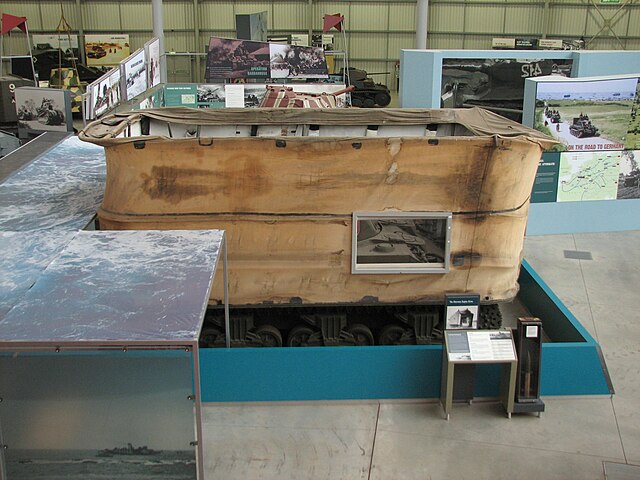
The Sherman DD is part of solutions that emerged from multiple problems linked to the largest amphibious landing in history, bar Operation Olympic against Japan in the spring 1946, which was several fold its scale. All agreed that infantry needed support on the beaches that tanks could provide, however a LCT (Landing craft, tank) and more so an LST (Landing ship Tank) were conspicuous targets for the German coastal artillery. Some argued that these vessels would be only permissible to approach when this coastal artillery had been neutralized by infantry, as doubts subsisted about the efficience of aerial bombardments for this. LCTs and LSTs being relegated to the 3rd wave, or after the beachhead was estabished, left a gap in infantry support that needed to be adressed, either with a dedicated amphibious tank or a conversion.
The first solution was already setup for the needs of the USMC in the Pacific, and was sorely lacking in Britain. Vehicles such as the LVT-1 Alligator were not intended for direct support but troop transport across coral areas that would have wrecked any Landing craft. The normandy beaches however were very different than volcanic atolls. The true problem that no LVTs coulds be spared from the Pacific in April-May 1944 as they were badly needed. Landing crafts were also in short supply, so much so the second opration planned in the French Riveria (Operation Dragoon) was postponed for two months in order to gather enough landing craft for Operation Overlord.
The British in particular and USN devised specially modified version of thee numerous landing crafts/ships as close support ships (notably with rockets or artillery) and there was the armada further out providing close artillery support. Still, the infantry needed close support on the beach themselves and there was simply no time to develop a proper amphibious tanks, neither in Britain or in the US. Such project would have been decided in 1942 already to have production tanks ready by mid-1944 and have sufficient training.

The concept of "true" amphibious tanks, not assault transports such as the LVTs (The Germans planned their own with the Landwasserschlepper) was envisioned first by th British, Vickers made and produced in small quantities their own Amphibious light tank for export, later mass produced by the Soviet Union as the T-37A and T-38. The Japanese had a go on the concept with the Type 2 Ka Mi. Unlike the former Vickers type which had floatation mudguards on either side of the hull plus buoyant parts, the Ka-Mi had jettisonable floatation halves (as the more confidential Ka-Chi), so this was also an option.
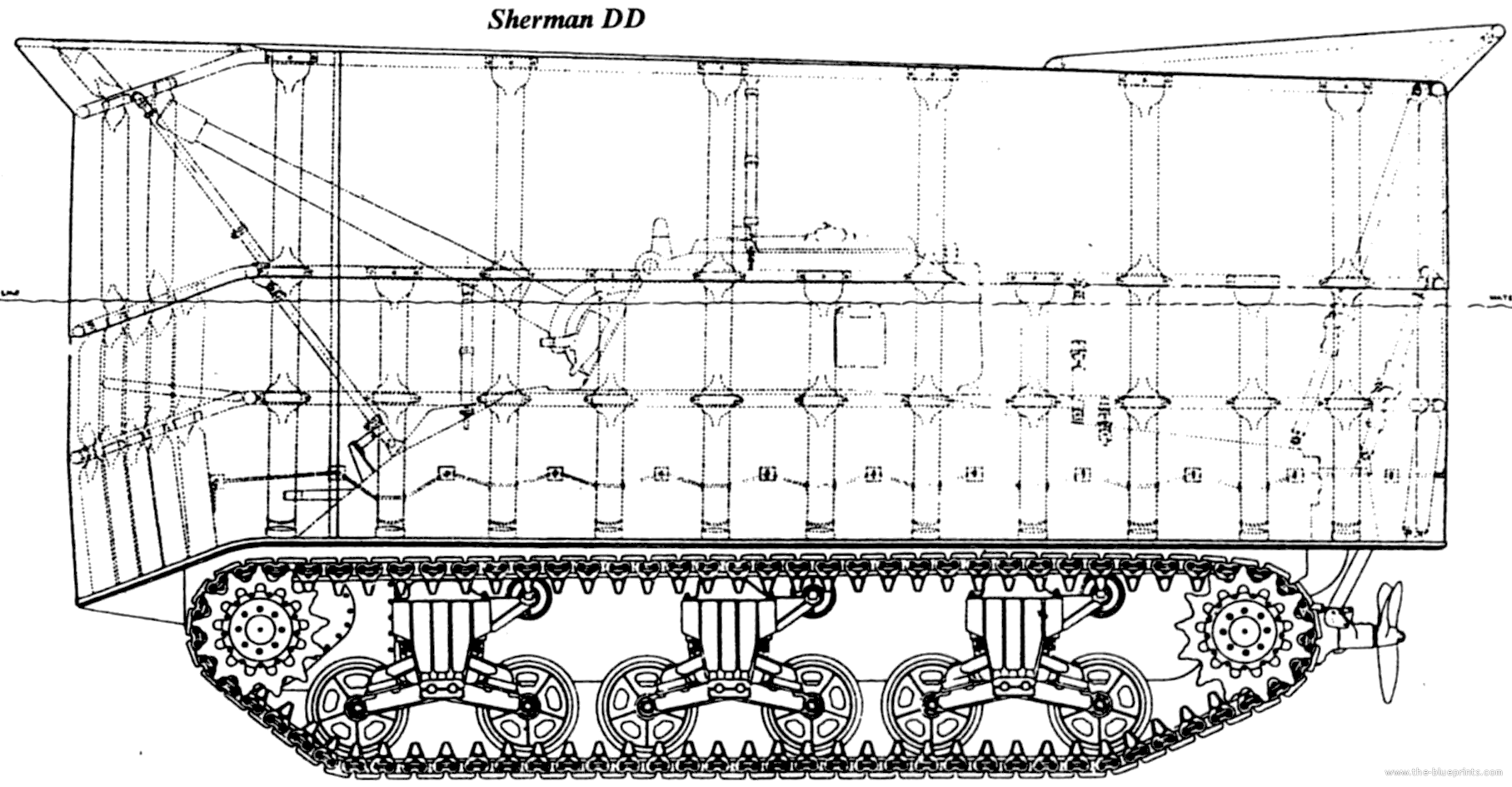
However the story of amphibians went back well before Early development, in 1918 the British Mark IX tank was the world's first amphibious APC, dubbed the "pig". It never saw action but setup a new trend. But tanks still poses unique problems of their own: The are immensely heavy due to their armour and there is very little internal free space so natural buoyancy is poor. Designs that could float unaided thus became small and very light, only filling reconnassance roles, such as the T-37. The British tested larger vehicle such as the AT1* which bulky hull provided extra buoyancy, but it proved impractical.
Straussler's floation screen concept
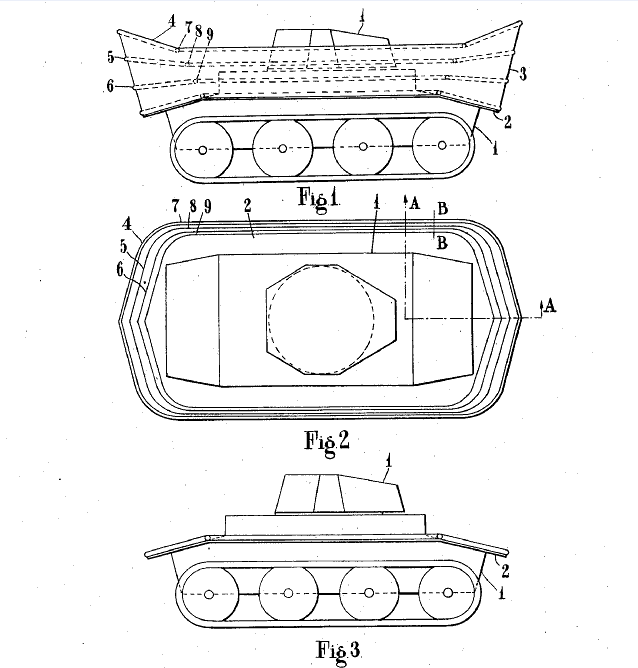
Diagram of a flotation screen fitted to a Tetrarch tank, taken from Straussler's patent, U.S. patent 2,390,747, issued 1945
Providing the required buoyancy for these tanks thus became a priority. If not constituted of jettisonable boat-like halves, another, more flexible system was needed. In Britain, Hungarian-born engineer Nicholas Straussler developed collapsible floats for Vickers-Armstrong. The latter wanted to propose a simple system adaptable to any model rather than designing and buidoing a brand new amphibioius tank from scratch. Straussler then worked on several solution to mounted devices on either side of a light tank to make it amphibious. Strauller also plugged to it an independent outboard motor that neede dto be activated by the crew externally. Trials conducted by the British War Office showed the new tank 'swam' reasonably well. This led to further studied revolving around medium tanks this time, a greater challenge as this was now up to 30 tonnes range.
Part of the "Hobart's Funnies"
"Hobart's Funnies" were a series of modified tanks and armored vehicles used by the British Army during World War II. These specialized vehicles were named after Major General Percy Hobart, who was instrumental in their development. Hobart's Funnies were designed to overcome the specific obstacles and challenges faced during amphibious landings and subsequent operations, particularly in the context of the Normandy Invasion (D-Day) on June 6, 1944. Amon these were the following:- Sherman Crab: Mine-clearing tank, M4 Equipped with a rotating flail forward to detonate mines safely ahead of the tank.
- Crocodile: Flamethrower tank. Turret mounted flamethrower instead of a main gun, and trailer carrying fuel for the flamethrower, based on the M4 Shrman or A22 Churchill.
- AVRE (Armoured Vehicle Royal Engineers), Churchill tank with a Petard mortar ("Flying Dustbin") for demolishing obstacles and bunkers.
- DD (Duplex Drive): The one we are speaking about. Valentine tanks were also equipped.
- Bobbin: Carpet-laying tank (Churchill) laying a roll of matting to provide traction over a sand beach
- Ark: Mobile bridge (Churchill) fitted with extendable ramps and platforms to create a gaping bridge for other vehicles.
- BARV (Beach Armoured Recovery Vehicle) (M4) beach special salvage vehicle, for towing and recovering disabled vehicles
- Fascine Carrier: Obstacle clearing (Churchill) carrying large bundles of wooden sticks to fill in ditches, create makeshift bridges.
- Kangaroo: Armored personnel carrier, Converted from exiting turret-less tanks.
Tactical use of the Sherman DD
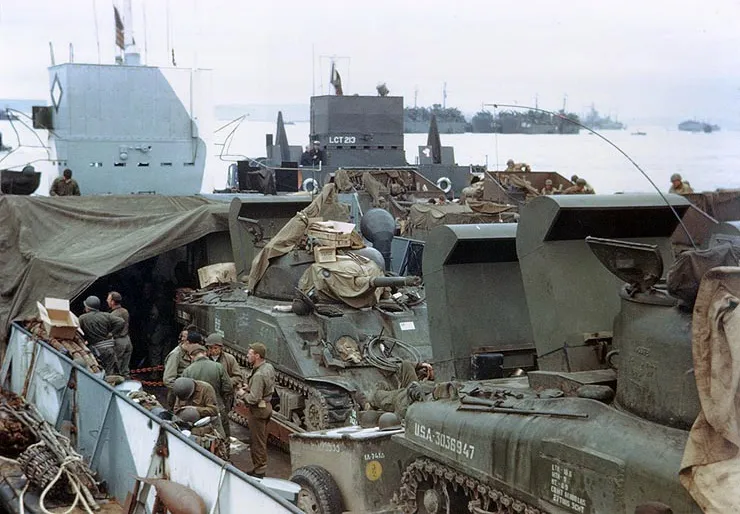
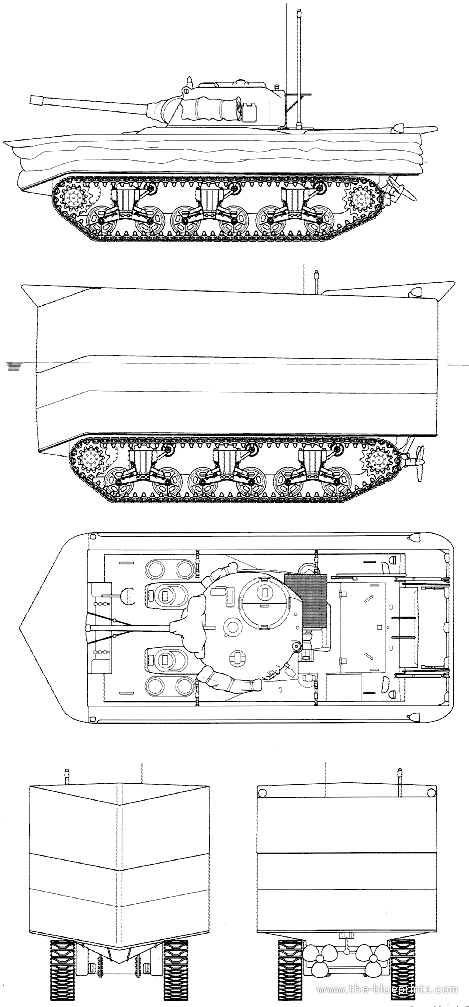 Not to expose LCTs (Landing Craft, Tank), the first wave was to be supported by self-propelled amphibious tanks, the infamous “Duplex Drive” of which the bulk were provided by Sherman DDs. The artificial buoyancy was provided by the large volum of air trapped inside a tall impermeable skirt attached to a frame and maintained high up. This obliged to modify the tank as well, welding all around a support metal skirt at the mudguard level, so above the drivetrain, on which was soldly, hemtetically attached the skirt. The second was to fit at the rear a rudder and propeller activated by the main tank transmission hence the “DD”. Once the tank had landed, the tranmission was decoupled to port full power on the tracks, but they were moving as well when swimming for additional motion.
Not to expose LCTs (Landing Craft, Tank), the first wave was to be supported by self-propelled amphibious tanks, the infamous “Duplex Drive” of which the bulk were provided by Sherman DDs. The artificial buoyancy was provided by the large volum of air trapped inside a tall impermeable skirt attached to a frame and maintained high up. This obliged to modify the tank as well, welding all around a support metal skirt at the mudguard level, so above the drivetrain, on which was soldly, hemtetically attached the skirt. The second was to fit at the rear a rudder and propeller activated by the main tank transmission hence the “DD”. Once the tank had landed, the tranmission was decoupled to port full power on the tracks, but they were moving as well when swimming for additional motion.
The engine deck was modified to avoid seeping too much water spray with an exhaust muffler coupled with a pipe. The idea was to launch them from a regular LCT, ramp lowered, and tyey would float to their destination, thus avoid exposing their carrier. Unfortunately bad weather, which already delated from 24h the Normandy landing was greenlight on June 6th, and this cost most of the DDs deployed. In these choppy seas, water rushed above the “bathtub” formed by these skirts and the pumps were not enough to avoid the tank sinking. For this reason the crew was dismounted, sitting over the tank in case. The driver was however unfortunate enough to be inside, un-buttoned and with his hatch open to escape quickly. Many drown with their tanks however.
Design
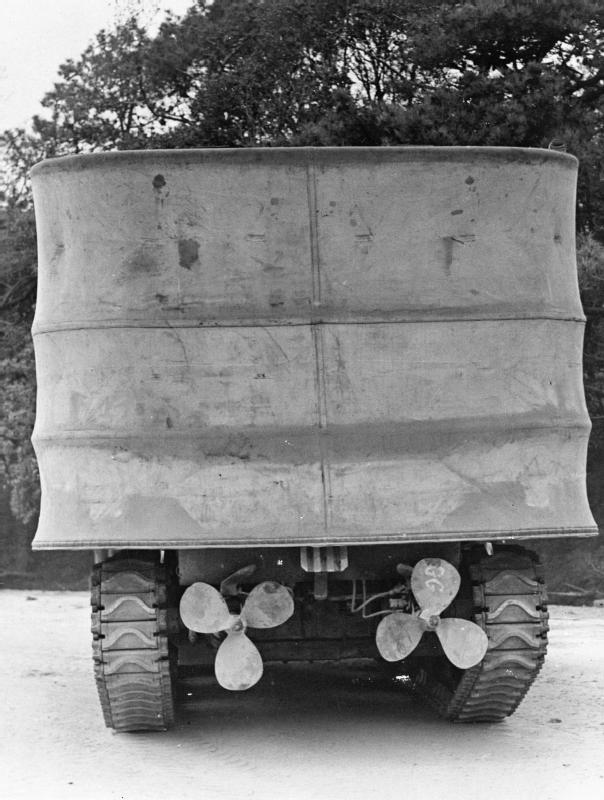
The M4 Sherman DD (Duplex Drive) was an amphibious variant of the M4 Sherman tank used during World War II, specifically designed for the D-Day landings on June 6, 1944. The "DD" stands for "Duplex Drive," referring to its capability to operate both on land and in water. The most significant feature of the Sherman DD was its ability to float and propel itself in water. This was made possible by a set of duplex drive propellers and a waterproof flotation screen made of canvas and supported by inflatable rubber tubes. The screen could be raised to provide buoyancy and lowered for land operations.


Duplex Drive: The Sherman DD had two drive systems—one for land and one for water. In water, a pair of propellers driven by the tank's engine provided propulsion. On land, it operated like a standard M4 Sherman tank using its tracks.
Flotation Screen: The flotation screen surrounded the upper part of the tank, giving it a boat-like appearance when deployed.
Water Propulsion: Propellers were mounted at the rear of the tank, driven by the tank's engine via a power take-off mechanism. Armament and Armor: The armament and armor of the DD variant were largely the same as the standard M4 Sherman, typically equipped with a 75mm or 76mm main gun, along with secondary machine guns.
specifications (M4/M4A1 DD) | |
| Dimensions (L-w-H) | 19 ft 2 in x 8 ft 7 in x 9 ft (5.84 x 2.62 x 3m)* |
| Total weight, battle ready | 66k Ib or 33.4-35 tons |
| Crew | 5: Cdr, Driver, Bow gunner, Main Gunner, Loader |
| Propulsion | Continental R975-C1/C4 9–cyl. RG 350/400 hp (261/298 kW)@2,400 rpm |
| Top speed | 22 mph (34 kph) land, 4 knots or 7 kph/4.3 mph |
| Suspensions | Vertical volute spring suspension (VVSS) |
| Range | 100 mi (160 km), uknown when swimming |
| Armament | 75 mm gun M3 (90 rds), .05 cal., 2x 0.3 cal. MGs |
| Armor | 12.7 to 80 mm (0.50 to 3.5 in) |



The M4 Sherman DD in action
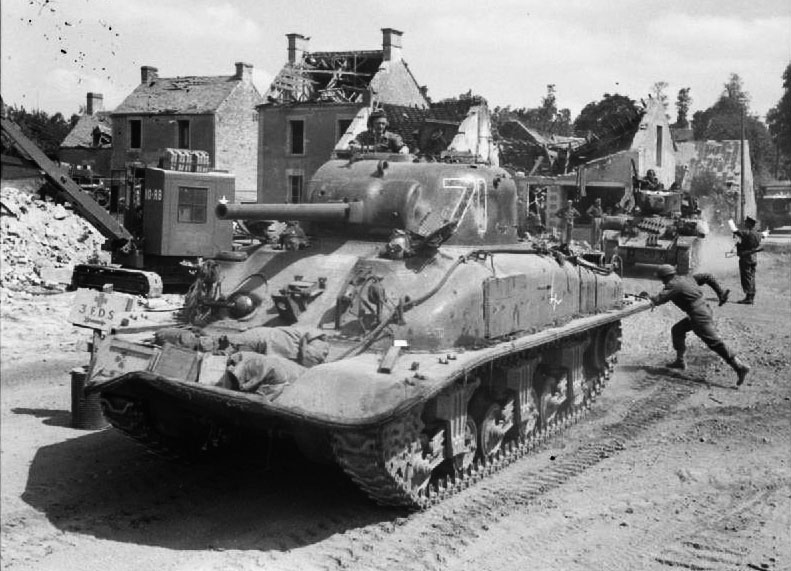
The Sherman DD was first engaged en masse during Operation Overlord, the D-Day Landings. The Sherman DD tanks played a crucial role in the Normandy beach assault, technically under the supervision of the Royal Navy under the umbrella of Operation Neptune. They were launched from landing craft several miles offshore and were supposed to swim to the beaches under their own power. While many Sherman DD tanks successfully reached the shore, some were lost due to rough seas and technical difficulties. Their success varied depending on the beach sector and conditions. The main use of DD tanks was on D-Day and later in Operation Dragoon (southern France August landing) as well as Operation Plunder (crossing of the Rhine, 23 March 1945) and on the Italian Front in 1945. Those sent to India in 1945 went to the 25th Dragoons and were trained, but planned operations in Malaya were cancelled.
Operation Overlord
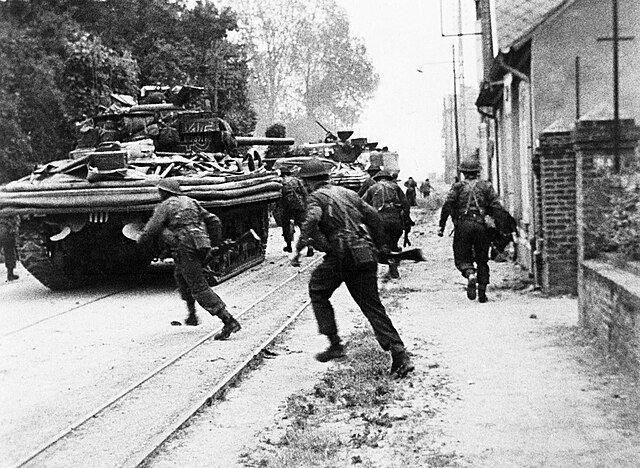
Men of No. 4 Commando engaged in house to house fighting with the Germans at Riva Bella, near Ouistreham. Sherman DD tanks of 'B' Squadron, 13/18th Royal Hussars are providing fire support and cover, 6 June 1944
Enough Sherman DDs were converted to equip eight tank battalions, spread between the American, British, and Canadian forces in the spring of 1944. They were all carried by Tank Landing Craft, or LCT of various Marks as the first four were British designed and built. Later the US provided hundreds of lend-lease ones (Mark 5 and 6). Capacity diverged for all but the most common generally carried nine Shermans, but less DDs, which were bulkier. So much in fact they did not fite side by side and hed to be interleaved. British and Canadian LCTs have five DDs each on board, American LCT(6) only had four, as they were shorter and less beamy.
The typical modus operandi was to have them launched 3 kilometres (2 mi) from the shore. They were forced to swim up to the beach and so bring to the first wave, just at the same time as the LCVPs brought infantry. Due to the difference in speed between the latter and the Sherman DDs, especially if the sea was rought, infantry arrived much sooner. Overall the use of the Sherman DDs that curcial day was reminded almost as an abject failure but there were some successes. The placed they were most needed unfortunately, at Omaha Beach was their worst performance, as most never reach the beach. Let's dive into the detail:
Sword Beach
On the British easternmost sector, DD tanks worked well as locally, the sea was "reasonably" calm. Those from 'A' and 'B' Squadrons attached to the 13th/18th Royal Hussars were launched ever further out, at 4 kilometres (2.5 mi) from shore, and only five failed to be launched as the leading tank tore its screen when trying to exit the LCT. The captain decided just to wait for reports on the situation over the beachhead, and when reassured, obtained permission to landed directly on shore. Another swam and sank when colliding with an LCT which punched through its screen. All the rest were safely ion the beach, breining a decisive support well inland in a relatively "quiet" sector.Gold Beach

DD tanks inland Further westwards, the second british sector Gold Beach experience a rougher sea, and in addition tanks of the Nottinghamshire Yeomanry (Sherwood Rangers) had to be launched late, to avoid them sinking underway, so the LCTs again waited for the beach to be reasonably safe to approach to 700 yd (640 m) and then launched them, which was relatively clsoe to the shore. Eight still were lost and when the last arrived Sherman Crab with their mine flail and heavy guns already had secured all German artillery and machine-gun positions. Tanks from 'B' and 'C' Squadrons (4th/7th Royal Dragoon Guards) were landed in shallow water, so they rolled with their screen up instead of swimming. German anti-tank guns barked in some place and cause a few losses, but the assault was an overall success.
Juno Beach
The Canadian sector of Juno Beach saw The Fort Garry Horse and 1st Hussars also equipped with DDs engaged initiallyk, but only the latter were launched, the other retained due to the choppy sea, and landed later very close to the beach for safety. Those DDs were supposed to cover the 7th Canadian Brigade, western end and LCTs launched them a various planes, from 4,000 yd (3,658 m) at the most and 800 yards (700 m) for others. Srill on 29 launched, 21 made it, 8 sank underway. 8th Canadian Brigade landed without DD tank support (they were supposed to be covered by the Fort Garry Horse DDs, but the terrain here cause very choppy seas and the captains decided not to launch the tanks. For this, the 8th Canucks suffered heavy casualties at first but they eventually secured their objectives.Utah Beach
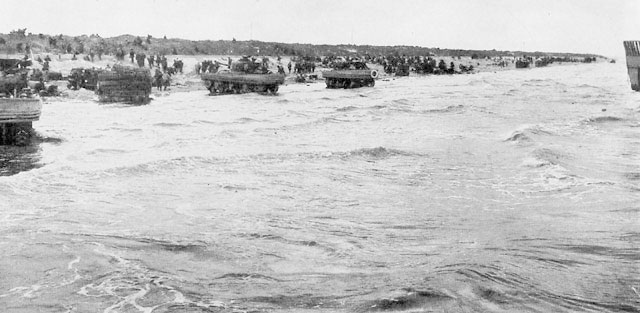
DD tanks at utah
On the westwards first US sector, Utah Beach, DDs came from the 70th Tank Battalion. However they were only eight. One of the LCTs was destroyed by German heavy gunfire, leaving only one, with four DDs launched 15 minutes late, and at 1,000 yards (914 m) from the beach. This dangerousely exposed the remaining LCT with DDs, but she was not damaged. There were other LCTs as well, which launched 28 DDs, of which 27 reached the beach, but unfortunately the massive smoke screen and currents brought them 2,000 yards (1,829 m) off from their aiming point. There was little infantry to cover there, but they took heavy fire still.
At around 7:45 a.m. the 3rd battalion attached to the 8th infantry landed at "Red Beach". The 3rd battalion moved to Exit 2 and access inland was granted. Some of the 70th tank battalion Sherman DDs joined and covered the 3rd battalion but along the causeway congestion formed as a German 88mm gun destroyed the road. Two Shermans were lost that day on this sector, one by cannon fire, the other by a mine on the road.
Omaha Beach
At Omaha Beach almost all DDs launched offshore were lost. For the infantry landed there, on the wrong sector to boot, faced heavy defences and took massive casualties. The Shermans were sorely missed there. Decision to launch the 112 DDs was controversial due to the choppy seas. In all, 56 were committed for the 741st and 56 for the 743rd Tank Battalions but they had 32 more DDs in reserv each as well as 24 other Shermans for special tasks, notably bulldozers. The assault started at 05:40, and the 741st Tank Battalion launched straight away from its LCTs some 29 DDs, just two made it to the beach. Crews from sinking tanks were sometimes able to launch a quick radio warning and urge to stop launchings. This it was decided for the remaining vehicles of the 741st TB and nearly all DDs from the 743rd Tank Battalion (One LCT was sunk, loosing four DDs aboard) were kept in reserve and only committed when "Dog One was open". They were landed directly on the beach at around 06:40 when most defences had been neuralized already. By default they were still useful to push forward.DD Failure: Who's responsible ?
The sole episode of Omaha was taken as base to propagate the myth postwar (mostly on the US side) that the DD concept was fundamentally flawed and that many well trained tank crews had been wasted. It should be reminded that DDs were designed to operate in waves up to 1 foot (0.3 m) high, wheras this detail was not known by local commanders, that perhaps optimistically or by necessity ordered to launch anyway. Wave measurements were not taken or not reported, and so the Shermans tried to swim in waves up to 6 ft (1.8 m) high, many time over that limit. This was never tested and resulted, just by the constant input of seawater spray inside, to swamp the interior and weigh more, until the level of the screen was low enough for waves to break over. Then it was very quick, the crew had seconds to act.Another point that was criticitzed later was the choice, to avoid artillery fire, to launch 741st Tank Battalion far out at 3 mi (4.8 km) offshore, the travel was already difficult as choppy seas negated the already slowed down speed of the tanks, which engines were pushed to the maximum. It was estimated that ideally on a lake-state sea, topo speed was 4 knots or 7 kph already, but there, it was down to 2 knots at best as the massive screen bulk and flexibility became a massive hinderance to move and retain any buoyancy overall. Due to the distance they stood no chances. There was already no way to steering these 35-ton totally un-hydrodynamic contraptions with such a low freeboard in that sea state. They were doomed from the start.
Still, crewmen stood a chance. They were equipped with DSEA or emergency breathing apparatus lasting for 5 minutes. By practice, they standed on the roof or deck during the trip and tried to scoop with their helmets, while the driver was stuck inside with the apparatus. There was also an inflatable raft on board, and it was often infkated before or during launch whatever the regulations were. So overall, despite all the losses, there were eventually few drawned crewmen overall. Most of the crews were rescued, many by landing craft of the 16th Regimental Combat Team. Only five drivers went to the bottom on this total, which was still sad but yet not as dramatic as portrayed post-operation. Much more shermans were destroyed and crews incinerated due to deadly German ambushes in the Normandy bocage.
Serious research was done in 2000, by the Institute of Nautical Archaeology by Texas A&M University with Robert's Naval Historical Center's (Underwater Archaeology Branch) and concluded that the LCTs in these strong currents particular to this sector and underestimated, were drifting away from the target beach and so the tanks launched had to set a catching course which tossed them obliquely in high waves, increasing water splashing over. Two of these DDs were fortunately skippered by men having sailing experience and they manoeuvered their tanks perpendicular to the waves, and were the only ones to made it to the beach. The myth of all DDs sinking almost immediately was deflated as the wrecked were all identified and many came within 1,000 metres of the shore, having made already 2/3 of their run.
Some were (according to testimonies) afloat for a few minutes but one struggled for 15 minutes, others for 10 minutes and the water spreaying was slow enough to have them realizing the problem and frantically lauinch radio calls to warn the command. All the issues encountered were proper to local conditions, as the sea was the roughest in this particular sector, mostlt due to the particular "horn" nortwards and the much stronger currents and winds that were combined by a too distant launch.
DDs in Operation Dragoon

Als called Anvil-Dragoon, these on 15 August 1944 were performed by French and US forces between Toulon and Cannes on the Riveria. The same procedures were repeated, but in the Mediterranean and with a proper meteo reporting, the use of 36 Sherman DDs that first day was greenlighted as "safe". Tank battalions that were equipped were the the 191st, the 753rd, and the 756th. The latter launched its eight tanks from "only" 2,500 yards (2,286 m), still two were lost, one swamped by the bow-wave of a passing by landing craft(manned by USCG drivers), one sank after striking an unknown underwater obstacle. The twelve from the 191st battalion were launched closer to the beach. Five from C Company, 191st Bat. ran into mines and lost tracks. The 753rd battalion's 16 tanks were split landed, with the remaining eight directly on the beach after the beachhead was secured. Overall only two losses at sea for 36 was seen as a good ratio. Dragoon was also called the "champaign campaign" and compared to the Atlantic wall, defences were relatively poor.
Battle of the Scheldt
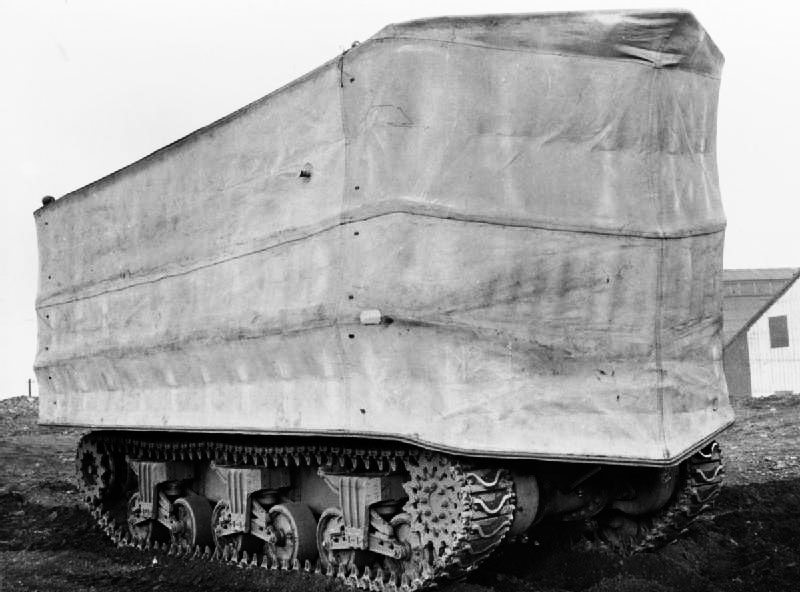
The Staffordshire Yeomanry DD tanks had time to train after D-Day at Burton-upon-Stather (Scunthorpe), and did extra training in Belgium. By September they were based as Elewyt, Hofstade Lake. On 26 October 1944 they were mobilized for the 7-mile (11 km) corssing of the Western Scheldt in direction of South Beveland (Battle of the Scheldt). Conditions were trhe complete opposite of Omaha Beach. They just went from a short, swam in lake-like waters, just as for tests. This was also their longest operational water crossing but when reaching the opposite shore, 14 became bogged down in mud, others just could not climb, leaving four to cover the advance.
Crossing of the Rhine
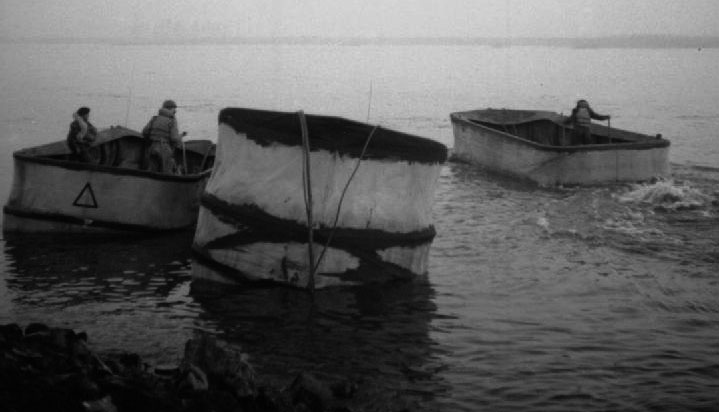
Sherman DD tanks crossing the Rhine, 24 March 1945
Operation Plunder was done in the night of 23 March 1945, seeing also the latest "funnies", the CDL conversions (former M3 with powerful light projectors). The Staffordshire Yeomanry tooo part again with new DDs, as well as those of the US 736th and 738th Tank Battalions and British 44th Royal Tank Regiment. The waters were more choppy due to the size of the Rhine there, currents were string at that time in the year and four were lost albeit it was an overall success. Tanks entered the water upstream from their objectives, to be brought by the current to their intended landing point. There was a first wave prior of Navy LVT-1s Buffalos (many other types took part) which laid well visible Mats on these objective points, after lessons had been retained from the Scheldt. DDs in the follow-up wave just had to aim and then climb over the steep and muddy banks over these mats. DDs of the Staffordshire Yeomanry's crossed last the River Elbe at Artlenburg on 29 April 1945. There was no loss, as techniques had been well refined by then.
Italian campaign
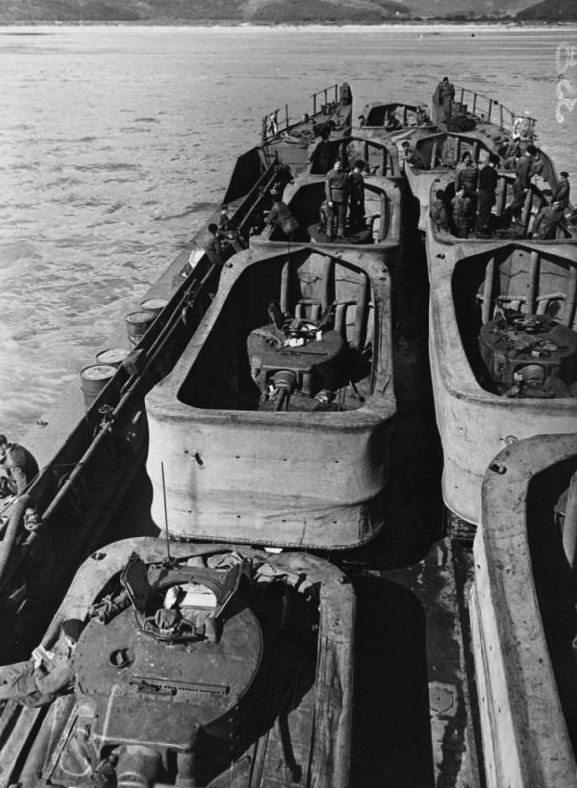
On February 1945, the 7th Queen's Own Hussars was also trained and equipped with DD tanks but mixed both Shermans and Valentines. Shermans crossed the Po River on 24 April without any loss. On 28 April, they performed assault across the River Adige. This time they were helped by Valentine DDs in second wave tasked to transport fuel. This became their only active use in WW2. DDs were used again towards Venice but after this there was no swimming operations. It was found there like in France and Germany, that when folded, the flotation screen and their metal skirt underneath made a perfect seating area, so they performed ad hoc troop transports roles in quiet sectors, doubling Kangaroos there.
Legacy:
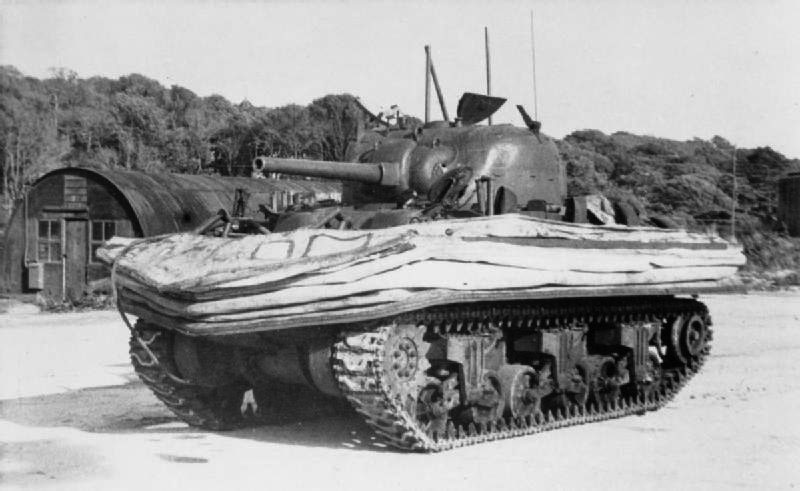
The development of the Sherman DD represented a significant innovation in military technology, combining elements of naval and armored warfare. The use of amphibious tanks like the Sherman DD demonstrated the importance of versatility and adaptability in military hardware, influencing post-war tank designs and amphibious assault strategies. However the skirt solution as seductive as it was because it was simple to iumplement and cheap, made the tanks vulnerable while in the water due to their slow speed and limited maneuverability, very dependent on sea Conditions: The effectiveness of the Sherman DD was heavily dependent on sea conditions.
Rough seas could easily compromise the flotation screens and lead to the sinking of the tanks. The M4 Sherman DD still, was an important development in amphibious warfare, contributing to the success of the D-Day operations and showcasing the innovative spirit of World War II military engineering. Nowadays, and throughout the cold war, amphibious tanks and troop transports had been a part of the inventory of nearly all countries with sime amphibious assets. More so, amphibious capabilities for all AFVs are considered mainstream, just as much as NBC protection. Some are buoyant enough to float, other are too heavy and limited to underwater river crossings with preparation.
Gallery
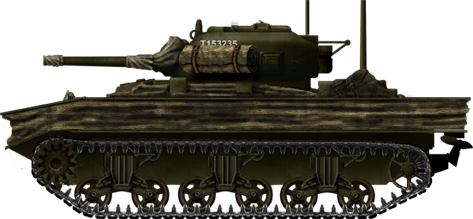
Sherman V at Juno Beach, 06 June 1944
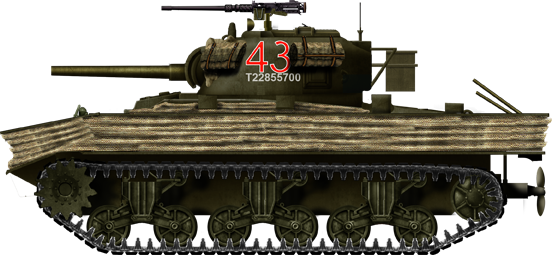
Mk V 13th/18th Hussars 27 Brigade Sword Beach
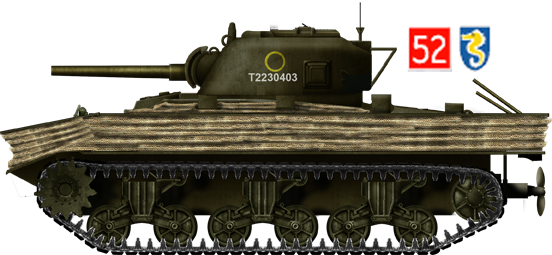
Mark V DD Staffordshire Yeomanry
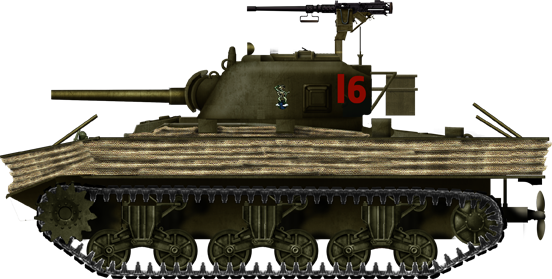
M4A1 "Anne" 7th Tank Co. Utah Beach
Private owned Valentine Mark IX, J. Pearson
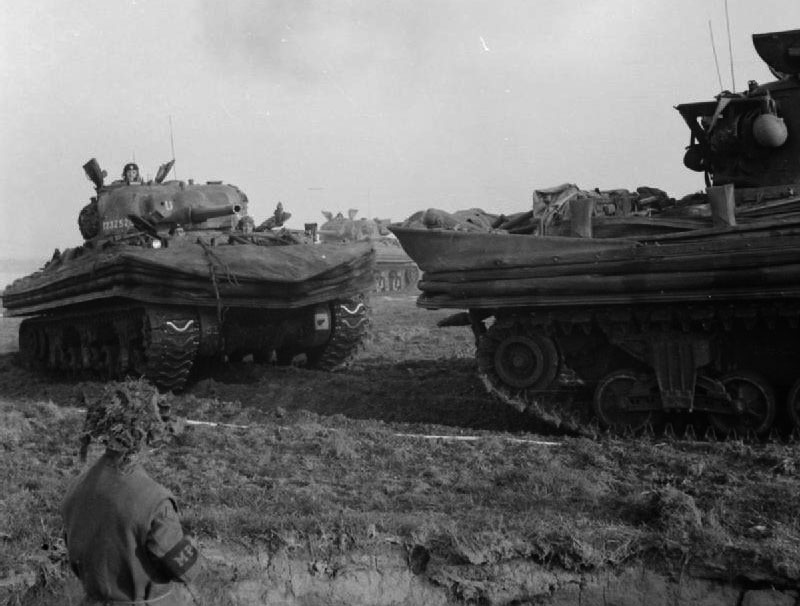
Sherman DDs 1945 Rhine Crossing
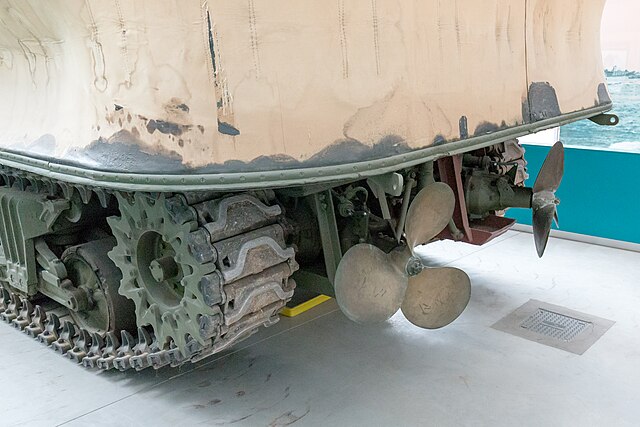
M4A2 Sherman DD propellers 2017 Bovington
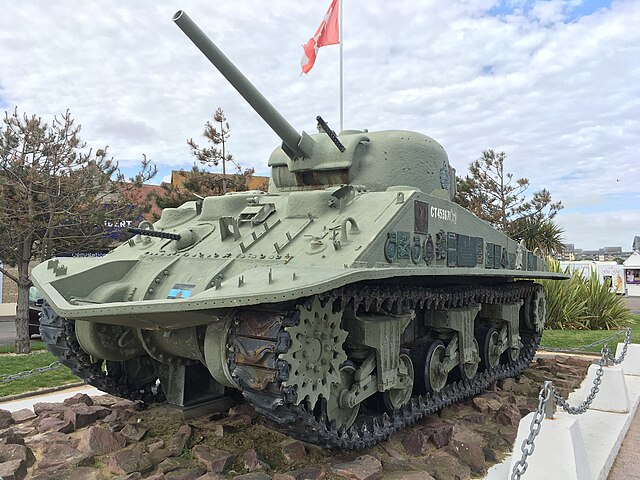
DD Sherman-1 Courseulles
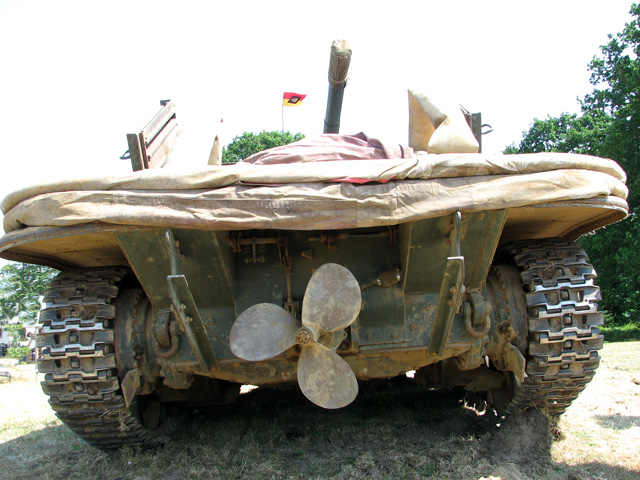
A Valentine amphibious tank at Fritton Lake, geograph.org.uk
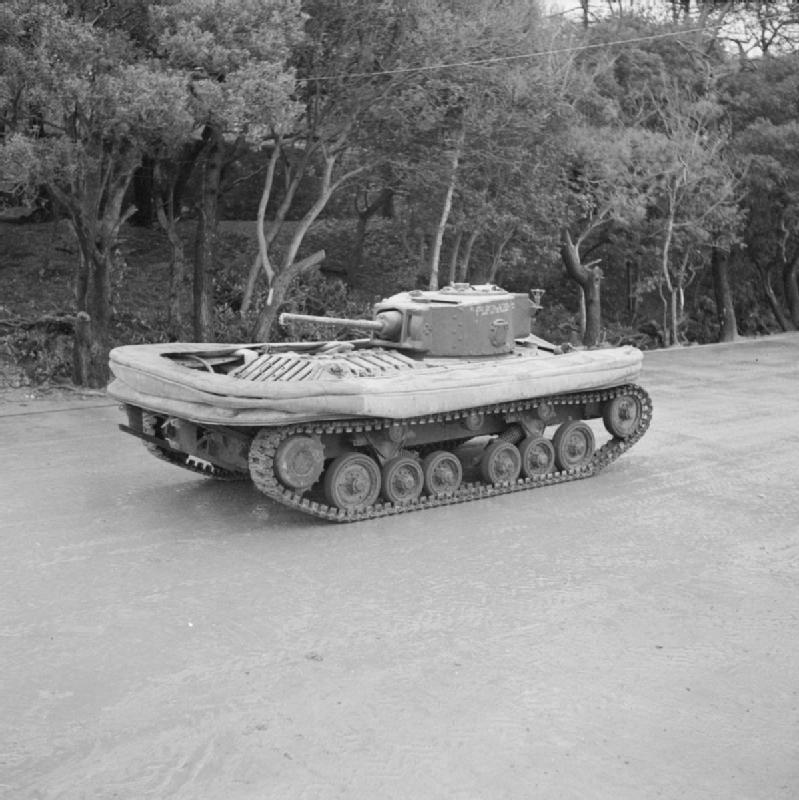
Valentine DD at Gosport 1944 IWM
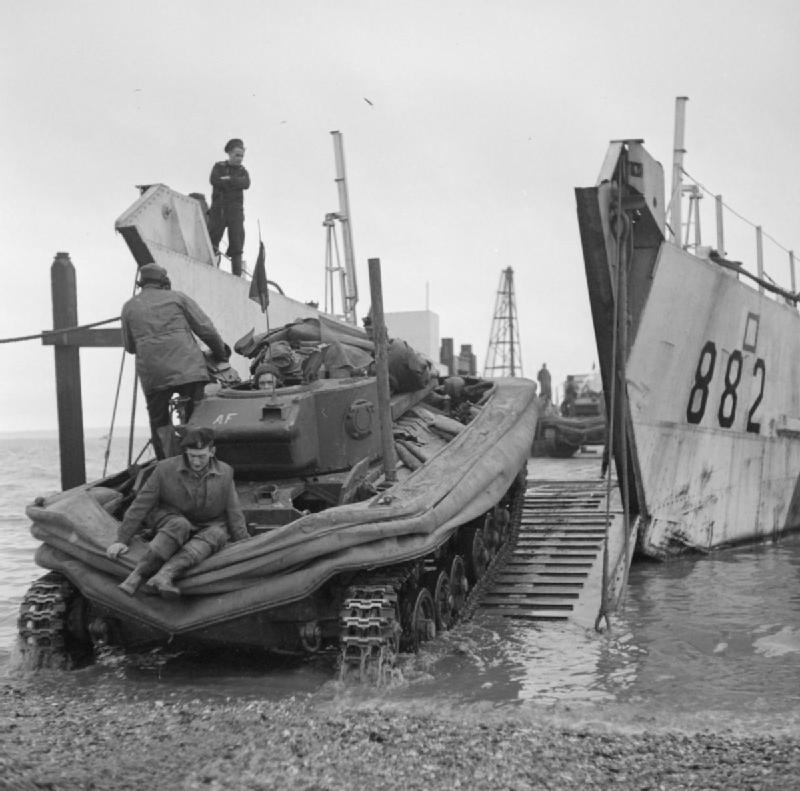
Valentine DD tank reverse landed from LCT(5)-882, 79th Armoured Division School Gosport 14 January 1944
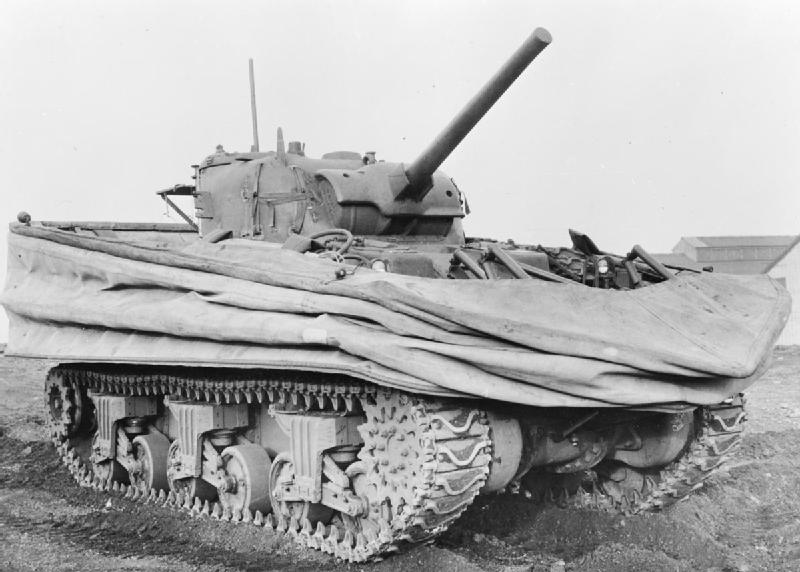
DD-Tank, presentation official ONI photo

Model kit showing it without the skirts inland

DDs and Deep Wading models
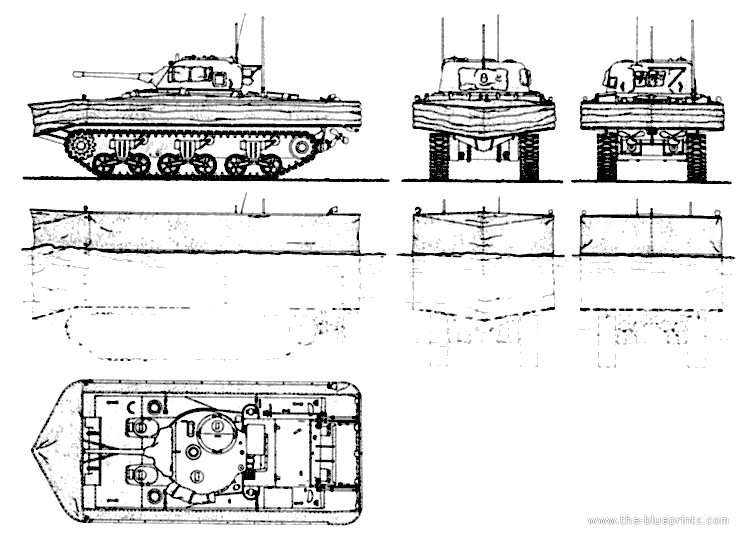
Blueprint
Read More/Src
Books
Evans, Martin Marix (2004). Invasion! Operation Sealion 1940. Pearson Education Ltd.Fletcher, David (2006). Swimming Shermans: Sherman DD amphibious tank of World War II (New Vanguard). Osprey Publishing
Fletcher, David (2007). Churchill Crocodile Flamethrower. Osprey Publishing.
Schenk, Peter (1990). Invasion of England 1940: The Planning of Operation Sealion. Conway Maritime Press Ltd.
Links
sproe.comwww.d-daytanks.org.uk
d-daytanks.org.uk
moaa.org
historylearningsite.co.uk
history.army.mil
duplexdrivetanks.co.u
junobeach.info
news.bbc.co.uk
dday-overlord.com
wiki DD_tank
flickr.com/
Videos

WW2 Tanks




























WW2 tanks posters

All Tiger tanks liveries.

Panther liveries and variants

WW2 Armour - All tanks











Tanks aces and single tanks series

Find more there

Museums, Movies, Books & Games
The Tanks and Armor in pop culture
Tanks and armored vehicles in general are only really grasped when seen first person: The mass, the scale, it's all there. Explore also the way tanks were covered in the movie industry, in books and in video games.Movies:
Best tanks movie on warhistoryonline.com
On imdb.com
On bestsimilar.com/
miltours.com
liveabout.com/
watchmojo.com
Video Games:
pcgamesn.com
historyhit.com
levvvel.com
vg247.com/best-tank-games
mmobomb.com/
alienwarearena.com
